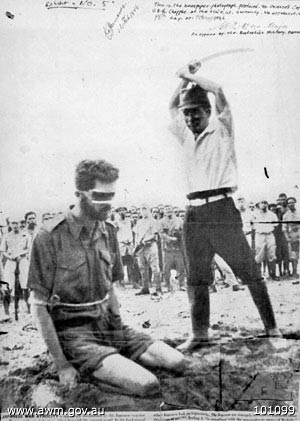B-29 CREWS TORTURED BY THE JAPANESE - Page 2
International and Japanese law
Although the Empire of Japan did not sign the Geneva Conventions, which have provided the standard definition of war crimes since 1864, the crimes committed fall under other aspects of international and Japanese law. For example, many of the alleged crimes committed by Japanese personnel broke Japanese military law, and were not subject to court martial, as required by that law. The Empire also violated international agreements signed by Japan, including provisions of the Treaty of Versailles such as a ban on the use of chemical weapons, and the Hague Conventions (1899 and 1907), which protect prisoners of war (POWs). The Japanese government also signed the Kellogg-Briand Pact (1929), thereby rendering its actions in 1937-45 liable to charges of crimes against peace, a charge that was introduced at the Tokyo Trials to prosecute "Class A" war criminals. "Class B" war criminals were those found guilty of war crimes per se, and "Class C" war criminals were those guilty of crimes against humanity. The Japanese government also accepted the terms set by the Potsdam Declaration (1945) after the end of the war. The declaration alluded, in Article 10, to two kinds of war crime: one was the violation of international laws, such as the abuse of prisoners of war; the other was obstructing "democratic tendencies among the Japanese people" and civil liberties within Japan.
In Japan, the term "Japanese war crimes" generally only refers to cases tried by the International Military Tribunal for the Far East, also known as the Tokyo Trials, following the end of the Pacific War. However, th�e tribunal did not prosecute war crimes allegati ons involving mid-ranking officers or more junior personnel. Those were dealt with separately in other cities throughout the Asia-Pacific region.

An Australian soldier, Sgt. Leonard Siffleet, about
to be beheaded with a katana
Aitape, New Guinea, 1943. An Australian soldier, Sgt Leonard Siffleet, about to be beheaded with a katana sword. Many Allied prisoners of war were summarily executed by Japanese forces during the Pacific War.
Japanese law does not define those convicted in the post-1945 trials as criminals, despite the fact that Japan's governments have accepted the judgments made in the trials, and in the Treaty of San Francisco (1952). This is because the treaty does not mention the legal validity of the tribunal. Had Japan certified the legal validity of the war crimes tribunals in the San Francisco Treaty, the war crimes would have became open to appeal and overturning in Japanese courts. This would have been unacceptable in international diplomatic circles. The current Japanese jurists' consensus regarding the legal standing of the Tokyo tribunal is that the execution and/or incarceration of an individual as result of the post-war trials is valid, but has no relationship to Japanese criminal law.
Historical and geographical extentOutside Japan, different societies use widely different timeframes in defining Japanese war crimes. For example, the annexation of Korea by Japan in 1910 was followed by the deprivation of civil liberties and exploitations against the Korean people. Thus, some Koreans refer to "Japanese war crimes" as events occurring during the period of 1910 (or earlier) to 1945.
By comparison, the Western Allies did not come into military conflict with Japan until 1941, and North Americans, Australasians, South East Asians and Europeans may consider "Japanese war crimes" to be events that occurred in 1941-45.
Japanese war crimes were not always carried out by ethnic Japanese personnel. A small minority of people in every Asian and Pacific country invaded and/or occupied by Japan collaborated with the Japanese military, or even served in it, for a wide variety of reasons, such as economic hardship, coercion, or antipathy to other imperialist powers.
Japan's sovereignty over Korea and Formosa, in the first half of the 20th century, was recognized by international agreements ? the Treaty of Shimonoseki (1895) and the Japan-Korea Annexation Treaty (1910) ? and they were considered at the time to be integral parts of the Japanese Empire. However, the legality of these treaties is in question, the native populations were not consulted, there was armed resistance to Japan's annexations, and war crimes may also be committed during civil wars.
| << previous page | next page >> |